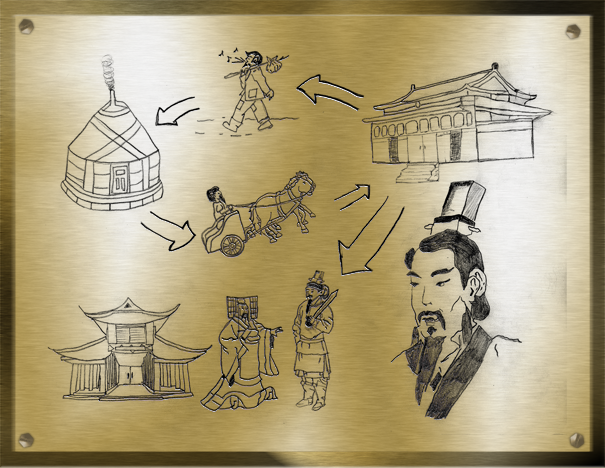| Time Period | Double Ears-Spring and Autumn Period |
| Geographical Region | None |
| List of Symbols |
|
My plaque is about Duke Wen of Jin, also known as Chong’er and Double Ears. This plaque describes his life and who he is. The bottom right symbol depicts who Double Ears is. Within the plaque, all representations of Chong’er is represented to have two ears on both sides of his head. I did this by drawing in an extra set of ears behind his regular ones. Wen’s home is represented by the top right symbol. This is expressing his home country, over which his father Duke Xian ruled before him. An arrow points from Double Ear’s home to the whistling traveller. This symbolizes his time of exile where he leaves his country of Jin and goes to the territory of the Di people. The hut in my plaque represents the Di area and during his time of exile, he stayed here for 12 years. An arrow points from the hut to the chariot. This symbolizes his return to power in the Jin. The chariot is tilted slightly up to represent a rise in power. The chariot is also important because it shows that he is a warrior. Double Ears would use chariots during battles and would overwhelm the barbarians who have never seen chariots before. Chariots were also fairly used during the Spring and Autumn Period. The palace located at the bottom left of the plaque represents the home of nearby rulers, such as the Zhou king. With the man next to the palace depicted as the King. The final arrow points from Wen’s home to Wen and this King together. This represents that the Zhou King proclaims Double Ears “Lord Protector”. I drew Double Ears with a sword to show that he is a protector and a warrior. There is a little time line effect that I subtly did within my plaque. Double Ears main symbol, the bottom right, depicts him with a long beard. I then added beards to each representation of Wen but with different lengths. The traveller has a small beard to show that Wen was young when he was exiled. Then the chariot symbol has a longer beard to show he has been gone for a while. Then the last depiction with Chong’er and his sword shows a long beard just like the symbol in the bottom right. Double Ears was Duke of Jin. The bottom right symbol depicts him with his crown. Only the bottom middle representation of Chong’er also depicts this crown. This symbolizes that Chong’er only became Duke after his exile and return. In life, Double Ears was a true warrior and strategist. He earned the respect of others, such as the Zhou King. This allowed him to become “Lord Protector” for the Jin and the surrounding areas with his skill. It was important to depict his exile since he spent about 19 years outside of his country. The chariot coming back to his hometown marks his return and rise to power. Other leaders from the surrounding area respected him, which is the main point of the bottom middle symbol of Chong’er with his sword and another king from another palace. Again, I drew ears behind the regular ears in all my representations of Double Ears. This allows one to depict who he is within the plaque. My plaque depicts most of Chong’er’s life. It shows Chong’er at his weakest being exiled and then at his strongest as “Lord Protector”.
 HENRY LE is from Rochester, NY. He is a senior at the University of Rochester. He’s studying physics and his minors are math and computer science. Henry enjoys playing euchre in his free time. More by Henry
HENRY LE is from Rochester, NY. He is a senior at the University of Rochester. He’s studying physics and his minors are math and computer science. Henry enjoys playing euchre in his free time. More by Henry
